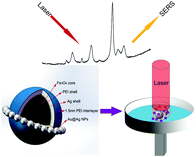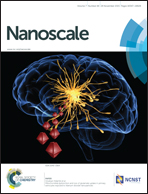Polyethylenimine-interlayered core–shell–satellite 3D magnetic microspheres as versatile SERS substrates†
Abstract
Precise fabrication of subtle nanogaps amid individual nanoparticles or between adjacent ones to obtain the highest SERS enhancement is still a challenge. Here, we reported a novel approach for fabricating core–shell–satellite 3D magnetic microspheres (CSSM), that easily form a porous 1.5 nm PEI interlayer to accommodate molecules and create sufficient hotspots between the inner Fe3O4@Ag core and outer assembled Au@Ag satellites. Experiments and finite-difference time-domain (FDTD) simulation demonstrated that the enhancement factor (EF) was about 2.03 × 108 and 6.25 × 106, respectively. In addition, the micro-scale magnetic core endowed the CSSM with a superior magnetic nature, which enabled easy separation and further enhanced Raman signals due to enrichment of targeted analytes and abundant interparticle hotspots created by magnetism-induced aggregation. Our results further demonstrated that the CSSM is expected to be a versatile SERS substrate, which has been verified by the detection of the adsorbed pesticide thiram and the non-adsorbed pesticide paraquat with a detection limit as low as 5 × 10−12 M and 1 × 10−10 M, respectively. The novel CSSM can overcome the long-standing limitations of SERS for the trace characterization of various analytes in different solutions and promises to transform SERS into a practical analytical technique.


 Please wait while we load your content...
Please wait while we load your content...